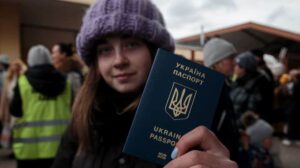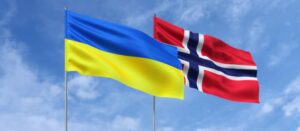
As of December 31, 2024, 4 million 260.08 thousand non-EU citizens who fled Ukraine as a result of the Russian invasion on February 24, 2022, had temporary protection status in the EU, which is 25.59 thousand, or 0.6%, more than a month earlier, Eurostat reports.
“The largest absolute increase in the number of beneficiaries was observed in Germany (+8830; +0.8%), Poland (+3705; +0.4%) and the Czech Republic (+3435; +0.9%),” the agency said.
It is noted that the number of people under temporary protection in December decreased only in Denmark (-1,995; -5.1%), Italy (-1,310; -0.8%) and France (-595; -1.0%).
According to Eurostat, Germany remains the country with the largest number of refugees from Ukraine in the EU and the world by a growing margin – 1 million 161.45 thousand by the end of 2024, or 27.3% of the total number of beneficiaries in the EU.
The top three also includes Poland – 991.63 thousand, or 23.3%, and the Czech Republic – 388.63 thousand, or 9.1%.
Spain (226.62 thousand), Romania (179.72 thousand), and Italy (163.10 thousand) follow with a significant lag.
According to Eurostat, in general, in 2024, the number of migrants from Ukraine with temporary protection status decreased by 52.14 thousand people, but at the end of 2023, the data from Switzerland, where 68.05 thousand such citizens are currently staying, was not taken into account.
In Germany, in 2024, the number of refugees from Ukraine with temporary protection status decreased by 89.80 thousand due to the data update at the end of 2023, while in Poland it increased by 36.84 thousand, in the Czech Republic – by 15.59 thousand, in Spain – by 31.70 thousand, in Romania – by 33.87 thousand, and in Italy – by 1.73 thousand.
In recent months, Eurostat has also clarified that the data for Spain, Greece, and Cyprus take into account some people whose temporary protection status is no longer valid.
According to the agency, compared to the population of each EU member state, the largest number of temporary protection beneficiaries per thousand people at the end of 2024 was observed in the Czech Republic (35.7), Poland (27.1) and Estonia (25.8), while the corresponding figure at the EU level is 9.5.
It is also worth noting that at the end of 2024, Ukrainian citizens accounted for more than 98.3% of temporary protection beneficiaries. Adult women accounted for almost half (44.8%) of temporary protection beneficiaries in the EU, children for almost a third (31.9%), while adult men accounted for less than a quarter (23.2%) of the total. A year earlier, the share of women was 46.2%, children 33.2% and adult men 20.6%.
More than 100 thousand people with temporary protection status at the end of 2024 were also in Slovakia – 131.53 thousand, the Netherlands – 121.30 thousand and Ireland – 109.99 thousand.
Between 50 thousand and 100 thousand of them were in Belgium – 87.24 thousand, Austria – 85.56 thousand, Norway – 78.77 thousand, Finland – 69.39 thousand, Bulgaria – 68.94 thousand, Switzerland – 68.05 thousand, Portugal – 65.29 thousand and France – 58.53 thousand (data on children are mostly not included – Eurostat).
This is followed by Lithuania – 48.25 thousand, Latvia – 48.09 thousand, Sweden – 46.41 thousand, Hungary – 39.17 thousand, Denmark – 36.92 thousand, Greece – 32.537 thousand, Estonia – 35.44 thousand, Croatia – 25.95 thousand, Cyprus – 22.16 thousand, Iceland – 4.2, 22 thousand and Liechtenstein – 0.70 thousand.
Eurostat clarified that all data relate to the granting of temporary protection on the basis of EU Council Decision 2022/382 of March 4, 2022, which establishes the existence of a massive influx of displaced persons from Ukraine due to Russia’s military invasion and entails the introduction of temporary protection. On June 25, 2024, the European Council decided to extend temporary protection for these persons from March 4, 2025 to March 4, 2026.
According to updated UNHCR data, the number of Ukrainian refugees in Europe as of January 16, 2025, was estimated at 6.303 million, and in the world at 6.863 million, which is 49 thousand more than as of December 16.
In Ukraine itself, according to the latest UN data, there are 3.6 million internally displaced persons (IDPs), approximately 160,000 people displaced from the frontline areas in the east and south between May and October 2024 due to the intensification of hostilities.
As Deputy Economy Minister Serhiy Sobolev noted in early March 2023, the return of every 100,000 Ukrainians home results in a 0.5% increase in GDP. In its January inflation report, the National Bank estimated the outflow from Ukraine in 2024 at 0.5 million (0.315 million according to the State Border Guard Service). The NBU also maintained its 2025 outflow forecast at 0.2 million.
Source: http://relocation.com.ua/the-number-of-refugees-from-ukraine-in-eu-es/

Ukrainians who had a permit for temporary collective protection from war in Norway, but whose permit was revoked or not renewed, cannot subsequently obtain it again.
The corresponding tightening to the protection rules was adopted by the Norwegian Ministry of Justice and Public Safety on May 31, according to a press release from the agency.
“Norway spends a lot of money on accelerated processing and resettlement of Ukrainian asylum seekers under a special scheme. The Center Party and the Labor Party in the government think it is wrong that asylum seekers who have voluntarily returned or have broken the rules should receive special treatment again,” Norwegian Justice and Public Safety Minister Emilie Enger Mehl said.
According to the Directorate of Immigration, about 2,000 Ukrainians with temporary collective protection have not received an extension of their one-year residence permit in Norway. In many cases, these are people who have moved back to Ukraine or other European countries. These people will no longer be able to receive collective protection in Norway if they apply for it again; instead, they will be referred to the normal individual asylum procedure.
The Minister also does not rule out the possibility of further tightening the rules for temporary collective protection in Norway.
“Immigration must be sustainable. We are therefore considering further tightening of the temporary collective protection scheme,” Mel indicated.
As reported, on March 11, 2022, the Norwegian government introduced a temporary collective protection scheme for displaced persons from Ukraine. This scheme means that those covered by it are granted a residence permit under a simplified procedure and without individual assessment.
According to Eurostat, at the end of March this year, Norway had 70.69 thousand citizens with temporary protection status from the war in Ukraine, compared to 52.61 thousand at the end of August 2023 and 66.94 thousand at the end of 2023.
A total of 4 million 211.5 thousand citizens of non-EU countries who left Ukraine as a result of the Russian invasion on February 24, 2022 had temporary protection status in the EU countries as of March 31, 2024. Ukrainian citizens accounted for more than 98% of temporary protection beneficiaries.
According to Eurostat data, at the end of March 2024, the main EU countries that received temporary protection beneficiaries from Ukraine were Germany (1 million 301.79 thousand people; 30.9% of the total), Poland (955.52 thousand people; 22.7%) and the Czech Republic (364.38 thousand people; 8.7%). The combined share of these three countries is 62.3%.

The majority of Ukrainian refugees and internally displaced persons surveyed (65% and 72% respectively) still express a desire to return home one day, but their share has decreased.
This is evidenced by the study of the UN Refugee Agency (UNHCR) “Life in Waiting: Intentions and Prospects of Refugees, Refugee-Repatriates and IDPs from Ukraine”, the results of which are published on its website.
According to UN data, the share of refugees who plan or hope to return to Ukraine in the future has decreased compared to last year (from 77% to 65%), but the share of those who are undecided about returning has increased (from 18% to 24%), as well as those who have no hope of returning (from 5% to 11%). A similar trend is observed among internally displaced persons.
According to the report on the results of the survey, the interviewed IDPs predominantly named the danger in Ukraine as the main factor hindering their return. Other problems were the lack of economic opportunities and housing. A significant part of the interviewed Ukrainian refugees (about 59%) indicated that they may be forced to return home if they continue to face problems in the host countries, mainly related to work opportunities and legal status.
It is also noted that more refugees are now making short-term visits to Ukraine – almost 50% compared to 39% last year, mainly to visit family members but also to check on their property.
The UN believes that such visits may eventually contribute to fully informed decisions on long-term return when conditions are conducive.
The UN recalls that there are now nearly 6.5 million refugees from Ukraine seeking asylum around the world and nearly 3.7 million people remain internally displaced.
UNHCR’s report is based on interviews conducted between January and February 2024 with nearly 4,000 refugee households in Europe, 4,800 internally displaced households in Ukraine and about 1,100 refugee households returning to Ukraine (total sample of over 9,900 households).

The situation with Ukrainian refugees is not improving, and a more active state policy is needed, says the Center for Economic Strategy (CES) in its report “Refugees from Ukraine: Intentions to Return, Impact on the Ukrainian Economy and Recommendations for State Policy.”
“According to different scenarios, from 1.3 million to 3.3 million Ukrainians may remain abroad. This is 0.4-0.6 million more than in the calculations for December 2022,” the document says.
According to CES estimates, as a result, the Ukrainian economy may lose 2.7% to 6.9% of GDP annually.
According to the researchers, the number of Ukrainians who have moved abroad is 5.6-6.7 million, which is 0.3-0.5 million, or 5% more than at the end of 2022.
“This was a result of the strikes on Ukraine’s power grid in the winter of 2022-23, the intensification of missile attacks on Ukrainian cities in May, and the explosion of the Kakhovka hydroelectric power plant in early June 2023,” the study says.
It is specified that 63% of refugees, according to a study by Info Sapiens commissioned by the CES, plan to return to Ukraine, but this share is falling.
“We are not sure that all of them will really return. First of all, the longer the war lasts, the more Ukrainians adapt to life abroad. In addition, some Ukrainians (6.8%) believe that the prospects for their children are better abroad,” the document says.
According to it, people with higher incomes before the war are more likely to return, while people with higher incomes now are less likely to return. In addition, students are one of the largest groups who would like to stay abroad.
It is noted that the majority of refugees are women (the largest share of women aged 35-49 is 18%) and children. Compared to 2022, the share of children has slightly decreased from 52% to 51%, with girls and boys being approximately equal among them.
Among adults, the proportion of men slightly increased from 17% in November 2022 to 22% in May 2023, in particular among people with temporary protection status in the EU – from 27% to 29%.
It is specified that the distribution of Ukrainian refugees by country of residence has also changed: the share of Poland has decreased from 42% to 29%, while the share of Germany has increased from 18% to 26%.
It is noted that a significant number of Ukrainian refugees lost most of their income after the start of the full-scale invasion, but as of May 2023, the economic situation of Ukrainian refugees abroad has improved: the share of those who have to save on food or have enough money for food has decreased from 40% to 35%.
The CES has identified four groups of refugees using cluster analysis. The first group (25% of all refugees) are classic refugees: mostly middle-aged women with children who have moved to Poland. They are not very adapted to life abroad, as 41% of Ukrainians in this group have never been abroad before. In addition, they mostly lived in settlements that were outside the combat zone but were subjected to rocket attacks (central and western Ukraine, as well as Odesa region). Accordingly, the main reason for going abroad was fear for their own safety.
The second group (29% of all refugees) are quasi-labor migrants who went abroad not only because of the war, but also for work. They are the most adapted to life abroad, as 25% of people in this group have already had experience working abroad. Also, for this group, external factors – both the hostilities and the policy of the Ukrainian state – will have the least impact on their decisions to return to Ukraine.
The third group (29% of all refugees) are professionals, people who mostly work in their specialty and are less willing to work outside of it. They often had their own business before the war. This group is more loyal to Ukraine and more often than others plans to return to Ukraine.
The fourth group (16% of all refugees) is people from the war zone, Ukrainians who suffered the most from the war. People from this segment are the most ready to take steps to adapt abroad. At the same time, they also express the greatest readiness to return to another region of Ukraine if it is impossible to return to their home region. Their decision to return will depend on the conditions created for this.

Romanian authorities are introducing new rules for housing and food subsidies for Ukrainian refugees starting from May: now the money will be received only by those who have found a job, the EFE news agency reported.
In addition, those citizens of Ukraine whose children go to school in Romania will be able to count on the subsidies.
Under the new rules, the state will no longer pay housing costs to landlords who house refugees, and tenants will receive subsidies directly. Refugee camps will receive subsidies from the state as before. Details of these rules will be made public at a later date, the agency notes.
EFE explains that Bucharest has taken such measures against the background of a significant labor shortage in Romania. More than 3.8 million Ukrainians arrived in the country since February 2022, but the vast majority went to other European countries. According to Romanian authorities, about 110,000 Ukrainian refugees currently remain in the country, but less than 10 percent of them have a work contract.

The number of refugees from Ukraine registered for temporary protection or similar national protection schemes in Europe reached 4 million 751.07 thousand as of November 22, 2022, the Office of the UN High Commissioner for Refugees (UNHCR) said on its website.
In the month since Oct. 25, the increase was 324,32,000, up from 242,900 and 214,300 in the previous two months, respectively, and about 1.8 million in total since the end of May.
The largest increase over the past month showed Germany – about 206.5 thousand, Poland – about 38.9 thousand, France – about 14 thousand, Romania – 11.7 thousand and the Czech Republic – about 9.5 thousand.
According to data of the UNHCR, collected from the national governments, the most refugees with the status of temporary protection in Poland – 1 million 507.89 thousand, given that the country from Ukraine, according to the Polish border service, since the war arrived 8.008 million people, and in the opposite direction went to Ukraine 6.196 million.
They are followed by Germany and the Czech Republic, where the number of registered for temporary protection of refugees from Ukraine was 1 million 21.67 thousand and 462.41 thousand, respectively.
Italy still occupies the fourth place – 164,17 thousand (3,5 thousand more), and Spain closes the third place – 154,46 thousand (5,2 thousand more).
Great Britain follows after that – 146.2 thousand (7.8 thousand increase), and Bulgaria with amount of 146.03 thousand (3.3 thousand growth) – the only country where the number of registered with temporary protection is much more than the number of registered refugees from Ukraine – 51.86 thousand.
There are more than 100 thousand Ukrainians registered for temporary protection in two countries – France and Slovakia: 118.99 thousand (data as of October, 21) and 101.24 thousand (increase by 2,7 thousand).
From 50 thousand to 100 thousand refugees from Ukraine with temporary protection status are also in Romania – 87.89 thousand, Austria – 86.90 thousand (an increase of 2.1 thousand), the Netherlands – 79.25 thousand (data of September 30), Lithuania – 70.67 thousand (an increase of less than 2 thousand, as for other countries below, where the dynamics are not specified)
Switzerland is also among them – 69.61 thousand (an increase of 2.8 thousand), Ireland – 64.28 thousand (an increase of 3.8 thousand), Belgium – 59.53 thousand and Portugal – 52.88 thousand (data of October 3).
Sweden comes next with indicators of 25 to 50 thousand – 48.36 thousand, Finland – 43.81 thousand, Latvia – 42.82 thousand (an increase of 2.1 thousand),
Estonia – 38.73 thousand, Denmark – 34.95 thousand, Hungary – 32.27 thousand, Norway – 32.10 thousand are also in this category.
From 10 to 25 thousand refugees from Ukraine with temporary protection status in Greece – 20.0 thousand, Croatia – 19.13 thousand and Cyprus – 18.29 thousand.
In addition, the UN statistics on refugees from Ukraine received temporary protection status in Slovenia – 8.07 thousand, Montenegro – 6.96 thousand, Luxembourg – 6.76 thousand, Iceland – 1.77 thousand, Malta – 1.54 thousand, Serbia and Kosovo – 1.09 thousand and Liechtenstein – 0.36 thousand.
The UN also indicates countries with registered refugees from Ukraine, but no data on their status: Turkey (data of May 19) – 145 thousand, Moldova – 96.65 thousand, Georgia – 25.20 thousand, North Macedonia – 6.39 thousand, Azerbaijan – 3.94 thousand, Albania – 2.51 thousand, Armenia – 0.36 thousand and Bosnia and Herzegovina – 0.13 thousand.
The UN separately indicates Russia and Belarus, where the Ukrainian border was crossed by 2 million 852.4 thousand and 16.71 thousand people, respectively, but since October 3, the data for Russia are no longer updated, while for Belarus they are even older. According to the UN, the Russian Federation recorded all who crossed the border, while 16.43 thousand – in Belarus. There are no data on their status, as well as data on the Ukrainian border crossing in the opposite direction.
According to the UNHCR data as of November 22, a total of 15.592 million people left Ukraine since the beginning of the war (not counting the flow of people into the country), of which 7.584 million left for Poland, 2.852 million for Russia (data of October 3), 1.782 million for Hungary, 1.557 million for Romania, 953.9 thousand for Slovakia, 697.9 thousand for Moldova and 16.7 thousand for Belarus.
At the same time, according to the UN, from February 28 to November 22, 7.939 million people entered Ukraine (excluding Hungary, Russia and Belarus).
“Since the beginning of the Russian invasion, almost a third of Ukrainians have been forced to leave their homes. To date, this is one of the largest displacement crises in the world. In Ukraine, some 6.5 million people were internally displaced as of Oct. 27 as a result of the war,” indicates UNHCR, which increased its estimate of internally displaced people by 0.3 million.
UNHCR indicates that by mid-2021, there were only 53,47,000 Ukrainian refugees worldwide seeking appropriate status, including 36,49,000 in Europe.
The Ukrainian diaspora in the world as of mid-2020 was estimated by UNHCR at 6.1 million, including 5 million in Europe.